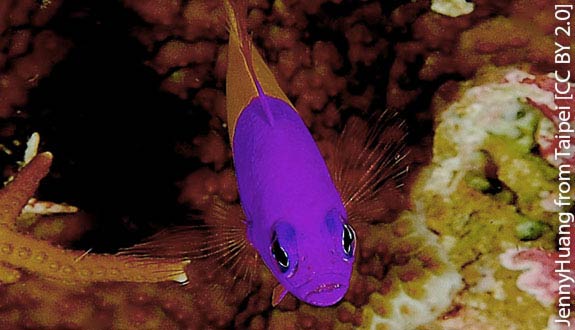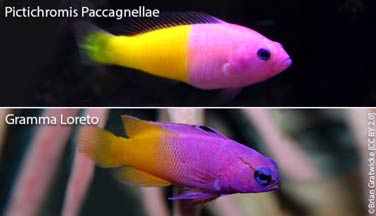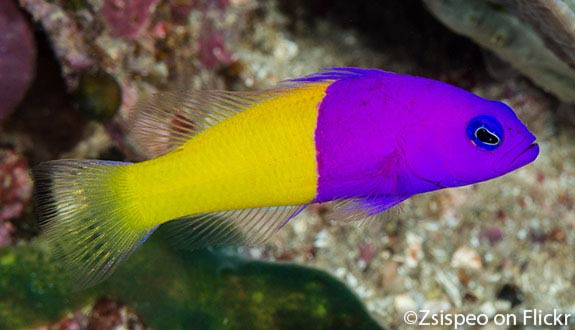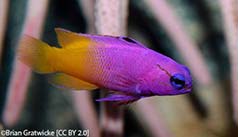

Alternative species (click on the thumbnail to see the card)
Names
Scientific name
Pictichromis paccagnellae
Common name
Royal dottyback
False Gramma
Bicolor Dottyback
Bicolor Cichlops
Twocolour Dottyback
Two-tone Dottyback
False gramma
Origin

Origin: Pacific Ocean, from Indonesia to Australia.
Natural habitat: Found in coral reefs (between 1 and 15 m or 40" and 590" of deep)
Dimorphism

None
Group

Pseudochromidae
Volume

200 L / 44 Imp gal / 53 US gal
Parameters

T°: 23 à 26°C or 73 to 79°F
pH: 7.5 to 8.5
Density: 1021 to 1026
Difficulty

Average
Size

7 to 10 cm (2.8 to 4")
Longevity

8 to 10 years
Living zone

Middle and depth
Individuals

1
Food
How to feed the Pictichromis paccagnellae?
Food
How to feed the Pictichromis paccagnellae?
Particularly difficult to feed, this lime-fish very rarely accepts traditional aquarium fish foods. In the wild, it feeds almost exclusively on corals of the Acropora type.
In the context of captive maintenance, this is really the black spot of this species: many fish die prematurely because of an unsuitable diet or a particularly recalcitrant fish. Here is the summary for the life of the vast majority of specimens: they are caught in the wild (they do not breed in aquarium), arrive hungry and weak at the store and end up dying at home very quickly. What a shame for these beautiful creatures! We can only encourage you to avoid this fish that should stay in its natural environment!
You can give him artemia that it will shyly peck at, but if it eats only that, its diet will not be complete and it may suffer from deficiencies. May also be proposed: pieces of nereis, mold flesh, lobster eggs, Mysis, krill, Formula 1 glitter, Eeze, Life Spectrum Marine Fish Formula, IO Marine Blend... Dry food must be moistened with water the whole aquarium and data (in case of persistent recalcitrant, soak them in artemia juice). Some aquarists rub food on coral polyps for consumption. Finally, complete with a cut of Acropora that you will sacrifice from time to time!
If your fish are getting lean, they are not eating enough. Put an Acropora cuttings in an emergency in their aquarium if none of the previously mentioned solutions worked. Meals will be distributed 2 to 3 times a day. You can add vitamin B to their food once a week, or concentrated enrichment solutions like Ultra Energizer or Selco for example.
Finally, note that the chance of proper feeding increases if you maintain a couple rather than an isolated individual.
Behavior
What kind of behavior does the Pictichromis paccagnellae have?
Behavior
What kind of behavior does the Pictichromis paccagnellae have?
The orange-tipped file is peaceful and sociable with all other fish species. It is quite fearful overall and does not leave its territory. You will see a lot of interaction between members of this species.
It spends a lot of time upside down, distinctive and fun feature of this kind of fish.
Cohabitation
Who can live with the Pictichromis paccagnellae?
Cohabitation
Who can live with the Pictichromis paccagnellae?
In the wild, this fish evolves into a couple once an adult (the juveniles form groups). In captivity, it must imperatively be maintained in the same configuration: in pairs. Besides, any attempt to maintain it alone will end in failure.
Avoid cohabitation with corals of the Acropora type and with the molluscs on which it feeds.
By its timid nature, also avoid maintenance with aggressive or very territorial fish. Prefer non-territorial or territorial fish but of calm nature. Remember that the more space there is in an aquarium, the more the cohabitations will go well!
Breeding
How to breed the Pictichromis paccagnellae?
Breeding
How to breed the Pictichromis paccagnellae?
Impossible in the aquarium.
Its aquarium
Which aquarium for the Pictichromis paccagnellae?
Its aquarium
Which aquarium for the Pictichromis paccagnellae?

A reef aquarium made of rocks and corals will be perfect for its maintenance. However, be careful not to introduce those of the Acropora type because the lime-fish are striving and destroying them systematically. On the other hand, they seem to be losing interest in soft corals.
It will take at least 600 liters or 132 Imp Gal or 158 US Gal for a community aquarium. In specific, you can go with a tank of 200 liters or 44 Imp Gal or 53 US Gal per fish, then add 100 liters or 22 Imp Gal or 26 US Gal per additional fish.
Do not subject the lime-fish to too much current, which may deplete it and limit its movement. Also be careful of your suction pumps because they can get stuck in it: protect them!
Good To know
Find all additional information!
Good To know
Find all additional information!
This fish is very difficult to feed, fragile and should be reserved for a handful of marine aquarium experts (its maintenance requires high level skills and know-how). Indeed, the mortality rate is very high. We can only encourage you to avoid the purchase of this species because there is very little chance that you will manage to maintain it and that your fish will eventually die quickly. By avoiding buying it, not only will you avoid a disappointment purchase, you will save money and discourage the trade of these fish that ultimately have nothing to do in private aquariums. Let us think that some animals cannot be kept in captivity and leave this little wonder in its natural environment!
It seems that young individuals acclimatize better to life in captivity than fish caught in adulthood that eventually die quickly.
Attention to its acclimatization: the one with orange spots is very sensitive to the variations of the parameters of water. Acclimatization should be slow and gentle. This will prevent the fish from becoming weak, fragile or ill. Note also its sensitivity to chemicals whose use should be carefully studied.
Its physical appearance is perfect camouflage to hide among the Acroporas it feeds. Another formidable weapon to its credit: it is able to diffuse different smells according to the situations. It can simulate the smell of the corals they rub shoulders to hide, or spread a smell reminiscent of toxic corals, or attract small crustaceans for its next meal.
This species is a cousin of the ballistae. It can be mistaken for Oxymonacanthus halli but it is smaller (7 cm or 2.76 inch) and has a shorter muzzle.
It owes its name of «lime» to its raspy skin recalling a file.

Yours photos!
Comments
Sort by:
Please login to post comments


